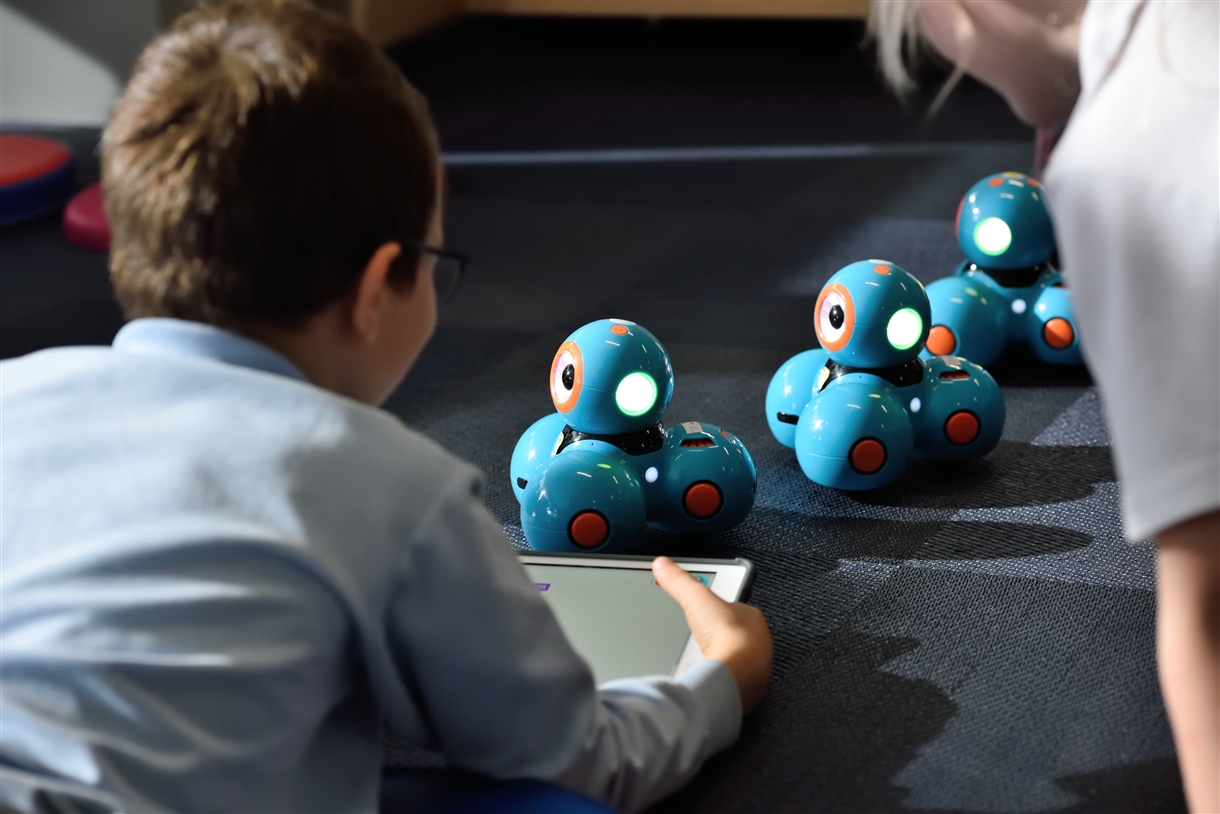Down the corridors of history, many systems and tools have been utilized to assist in child development.
In both school-based curriculum and at homes many domestic robots and digital devices are being incorporated as learning tools for kids.
From simplistic homemade toys such as matchbox to traditional toys such as dolls, balls, building blocks, and most recently high tech gadgets have been employed to aid in kids’ development. In particular, in the past few years, robotic toys for kids are gaining popularity in many households.
The use of robotic technology for kids’ toys has shown a significant positive impact on the lives of the little ones. It has long been known that home is the first school for kids and parents are first educators in their life. For this reason, parents are opting to gift their children with robotic toys. This way they can have fun and learn at the same time.
This does not mean the robotic toys replace the role of parents in interacting and being involved with their kids rather they assist them.
Why Toy Robots For Kids?
While toys are mainly seen as fun objects for kids they do more than being play items.Generally, toys have been shown to enhance children development. They entertain, enhance their creativity and spark their imaginations. For some reasons, kids tend to fall in love with robot toys. But what makes robotic toys stand out?
· They appear more ‘real’ and responsive because they are programmed to perform certain activities including talking, singing, barking, smiling, making eye movements, dancing and ·storytelling. This integration of machine-human aspect makes them appealing to kids.
· Some can record kid’s voices and play it
· They employ hands-on experience technique which actively engages them
· They are versatile and can be used to craft different designs
· They simplify technology and complex STEM principles such as programming to a level that matches children skills.
· Some are mobile and can ‘speak’ to kids
· Compared to humans robotic toys are non-judgmental, patient, do not get tired of repetitive actions and are child-friendly making them appealing to children especially those with developmental disabilities
· They are educative in a fun way of making them great learning buddies for kids
· Robotic kits pave way for their future success in career life
· They empower kids with computational and creative writing skills
How Robotic Toys Can Help Develop Toddlers And Preschoolers?
During this stage, kids are naturally curious, inquisitive, explorative, experimental and are continuously learning new skills.
For toddlers, robotic toys improve their motor skills. The hands-on building experience during physical tasks such as imitating clapping robots; building or linking items refine their fine motor skills. They are in particular attracted to creating light shows.
To expand on their knowledge of differentiating shapes and colors, the toys pieces come in various colors, sizes and shapes.
Some robots are programmed to enable kids to learn about body parts. For example, they may touch different body parts while naming them. This way kids learn by imitating what they do. This builds on their listening, language and identification skills.
To exercise their memory and language skills toys engage them by narrating rhyming stories and counting numbers.
When playing with robots toddlers can develop social skills such as singing, dancing and storytelling. Also, robot pets for kids such as Harry puppy are interactive and can talk, sing, walk and bark.
For preschoolers, they enjoy the educative aspect. They are slowly learning to count numbers and recite alphabets together with the robot. By listening to the pre-programmed stories they can learn to narrate these stories on their own.
Toddler-friendly robot toys are interactive and versatile to spark children creativity.
Why Coding Is Important To Learn For Young Kids
Back in the early days, it was assumed that coding was hard, boring and an entity preserved for males. But today our world has changed tremendously coding is now a key part in many sectors. It is perceived that in future that just like computer literacy is a mandatory qualification in almost in any career coding is the next big thing in the professional arena.
Robotic kits and coding toys have simplified and made computer programming and coding more fun for young kids. Take for example Birmingham’s Mohammad Hamza at the age of seven he won himself the title of the world’s youngest programmer while the ten-year-old Samaira Mehta from Silicon Valley has won the hearts of giant digital companies like Google and Microsoft.
These and many more young kids and teenagers that prove kids can learn coding and programming irrespective of their gender and age. While there is no right or wrong age to start learning to code the earlier the better.
Young children and teenagers are better learners when it comes to acquiring new skills. Also, children are driven by an unquenchable thirst to discover and explore challenging areas. In addition, this period lays a great foundation for their adulthood and shapes their future relations. As we advance in age it becomes harder to learn new complex skills. Perhaps it is due to the adults’ busy lifestyle and responsibilities that come with it.
While it is true that the internet offers myriad of tutorials about coding for kids there is undeniable beauty and power in learning to code using real and tangible items as compared to virtual learning. This is where robotic toys and robotic kits come in. In their own simple yet entertaining ways, they are able to capture children’s attention. The hands-on experience approach enables them to experiment.
Robot toys innovation has demystified the notion that it is difficult to master the art of programming. Coding robots especially the building ones has enabled kids to appreciate and simplify STEM skills. By doing it practically they are able to understand it better. Learning programming offers much more than gaining coding skills.
Robotic Stem Toys And Kits Impact on Teen’s
Robotic kits for teenagers range from beginners to more advanced levels. They are more advanced but still entertaining to capture their attention. Teens have a better grasp of programming and are able to read scripts, follow instruction and commands.
Since they are approaching the job market STEM gives them an advantage over their peers. Also because they are critical thinkers and love applying what they learn in a real situation they are likely to develop their own applications and robots.
Robotic Toys In The Lives Of Children With Special Needs
Many toys for kids are categorized by age bracket since most children acquire developmental milestone at specific time frames and in a predictable manner. But this is not usually the case with special needs children.
It takes patience, consistent practice and repetitive actions to learn skills. That is why there are assistive robot toys that are specifically designed with them in mind. For example, robot toys for autistic children offer them a companion and help to practice their social skills.
But just keep an eye on your kids11
The innovation of robot toy is a step in the right direction towards raising a generation of tech-savvy kids. They not only expose children to the world of coding early in life but they also brighten their future.
Just like video games as robotic toys continue to become popular in our society they can be addictive and obsessive hence parents should ensure that their children balance between real human interaction, physical activities and keep in touch with real world.


